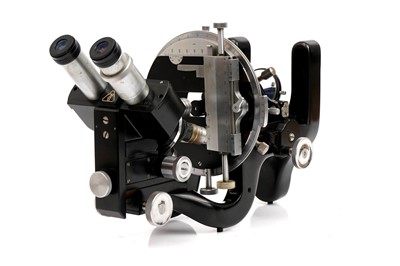26th Apr, 2019 12:00
Fine Photographica & Instruments of Science & Medicine
A Bausch & Lomb DDE Binocular/Monocular Research Microscope
American, c.1940, signed 'BAUSCH & LOMB OPT. CO. U.S.A. PAT.1.860.430, 1.826.031, ONE INT.=0.0025, CD5105', standing on heavy cast base, finished in black lacquer, plano-concave mirror on a tilting arm secured in place with a large knurled nut to one foot, mechanical substage with large swing out condenser to base, above is a swing out iris diaphragm with x adjustment via a micrometer wheel, above this is a dovetail slot to accept the condenser, which is engraved 'B. & L. OPT. CO. U.S.A. ACHROMAT 8.9mm 1.4N.A. SLIDE 1.5 - 1.6mm', substage assembly with very finely controlled rack and pinion adjustment via a small gear acting on a large gear acting on a rack, fully rotating large stage (155mm diameter) with a scale engraved around perimeter, slide holder locks in place at back of stage, course focusing is via two large chrome wheels to rear with fine focusing via smaller wheels to front, binocular head and monocular tube are interchangeable with a locking wheel to top of limb, complete with 3 original B&L eyepieces and various other eyepieces and objectives, mainly Watson, Watson objectives are all engraved 'EXP. PATH.', in original wooden case with drawer for accessories
Notes: B&L first introduced the new Model DDE into its range in 1929. It was described using the following (abridged) text:
“ DDE – A New Research and Photographic Microscope. The word “new” is so often used to describe a revamped apparatus that one hesitates to use it but in the case of this Research Microscope, the word “new” can certainly be used in the fullest sense of the word. This instrument is a radical departure from any existing type of microscope.
When we took under consideration the design of a new Research Microscope, we adopted the suggestion of Dr. Lester W. Sharp of Cornell University and of his associate Dr. L. F. Randolph of the U. S. Department of Agriculture and Cornell University of placing the arm at the front of the instrument, so as to give free access to the object, stage, objectives, sub-stage and mirror and thus offer greater convenience and comfort to the user. With the further aim of providing extreme rigidity we have eliminated the usual inclination joint for arm and pillars, which are made in one piece. The stage is thus always horizontal except when the instrument is used photomicrographically, when the entire instrument is placed in horizontal position resting upon three bosses provided on the two arms and base, thus leaving each part intact and in the vertical stage.”
Sold for £840
Result plus buyers premium
American, c.1940, signed 'BAUSCH & LOMB OPT. CO. U.S.A. PAT.1.860.430, 1.826.031, ONE INT.=0.0025, CD5105', standing on heavy cast base, finished in black lacquer, plano-concave mirror on a tilting arm secured in place with a large knurled nut to one foot, mechanical substage with large swing out condenser to base, above is a swing out iris diaphragm with x adjustment via a micrometer wheel, above this is a dovetail slot to accept the condenser, which is engraved 'B. & L. OPT. CO. U.S.A. ACHROMAT 8.9mm 1.4N.A. SLIDE 1.5 - 1.6mm', substage assembly with very finely controlled rack and pinion adjustment via a small gear acting on a large gear acting on a rack, fully rotating large stage (155mm diameter) with a scale engraved around perimeter, slide holder locks in place at back of stage, course focusing is via two large chrome wheels to rear with fine focusing via smaller wheels to front, binocular head and monocular tube are interchangeable with a locking wheel to top of limb, complete with 3 original B&L eyepieces and various other eyepieces and objectives, mainly Watson, Watson objectives are all engraved 'EXP. PATH.', in original wooden case with drawer for accessories
Notes: B&L first introduced the new Model DDE into its range in 1929. It was described using the following (abridged) text:
“ DDE – A New Research and Photographic Microscope. The word “new” is so often used to describe a revamped apparatus that one hesitates to use it but in the case of this Research Microscope, the word “new” can certainly be used in the fullest sense of the word. This instrument is a radical departure from any existing type of microscope.
When we took under consideration the design of a new Research Microscope, we adopted the suggestion of Dr. Lester W. Sharp of Cornell University and of his associate Dr. L. F. Randolph of the U. S. Department of Agriculture and Cornell University of placing the arm at the front of the instrument, so as to give free access to the object, stage, objectives, sub-stage and mirror and thus offer greater convenience and comfort to the user. With the further aim of providing extreme rigidity we have eliminated the usual inclination joint for arm and pillars, which are made in one piece. The stage is thus always horizontal except when the instrument is used photomicrographically, when the entire instrument is placed in horizontal position resting upon three bosses provided on the two arms and base, thus leaving each part intact and in the vertical stage.”
Auction: Fine Photographica & Instruments of Science & Medicine, 26th Apr, 2019


